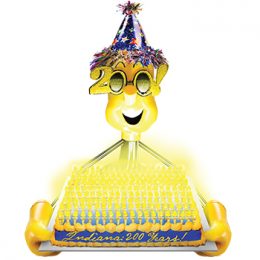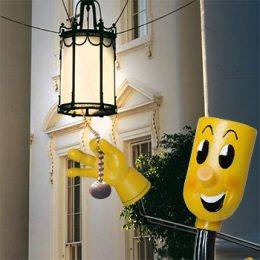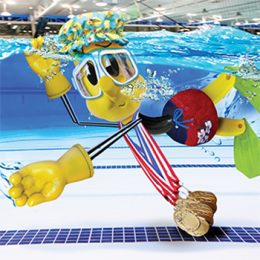Ten years ago, another 200th commemoration left a powerful legacy for Indiana. The bicentennial of the Lewis & Clark Expedition, 2003-2006, raised awareness that the historic “Voyage of Discovery” shoved off from the Hoosier shores of the Ohio River.
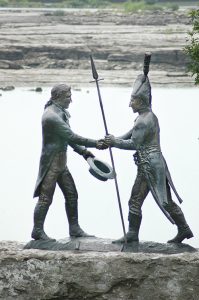
The co-captains of the Lewis & Clark Expedition, Clark on the left, are depicted in a bronze sculpture at the Falls of the Ohio River State Park in Clarksville, near where their depicted meeting took place.
William Clark was in the Indiana Territory in the late spring of 1803 not to lead men, engage Native Americans or accomplish any grand or glorious deed. It was for a task folks have been dispatched to do from the days of the Old Testament to present: Help a family member in trouble.
In Clark’s case, the 32-year-old former military captain came to Clarksville to help his older brother, Revolutionary War hero Gen. George Rogers Clark, then 50, untangle himself from a trail of debt worsened by alcohol abuse.
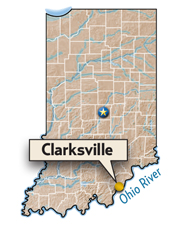 George Rogers Clark conquered the West for America during the Revolutionary War 25 years earlier. (Please see the February 2016 “Bicentennial Zingers.”) But he paid a heavy price for his service — literally and figuratively. As a lieutenant colonel in the Virginia militia, Clark ran up debts for supplies and equipment during his campaigns. When the creditors came calling after the war, Clark became an early victim of bureaucracy and poor bookkeeping. He never received full compensation from Virginia or the U.S. Congress to cover the IOUs. As his debts grew, Clark’s vast holdings of land he received for his war service were lost. Left with only a small plot of land in Clarksville, which is named after him, he built a cabin on a bluff high overlooking the falls of the Ohio River. Bitter, debt-ridden and demoralized, Clark turned to the bottle.
George Rogers Clark conquered the West for America during the Revolutionary War 25 years earlier. (Please see the February 2016 “Bicentennial Zingers.”) But he paid a heavy price for his service — literally and figuratively. As a lieutenant colonel in the Virginia militia, Clark ran up debts for supplies and equipment during his campaigns. When the creditors came calling after the war, Clark became an early victim of bureaucracy and poor bookkeeping. He never received full compensation from Virginia or the U.S. Congress to cover the IOUs. As his debts grew, Clark’s vast holdings of land he received for his war service were lost. Left with only a small plot of land in Clarksville, which is named after him, he built a cabin on a bluff high overlooking the falls of the Ohio River. Bitter, debt-ridden and demoralized, Clark turned to the bottle.
Meanwhile, in Washington, D.C., President Thomas Jefferson had tapped friend and protégé Meriwether Lewis to lead a military party into the vast, unexplored western half of the continent. Goals of the expedition would be to map the country, establish relations with the Native Americans and record unusual wildlife and plants found along the way. But the main objective of the “Corps of the Discovery” was to find a fabled “Northwest Passage,” a series of waterways that would allow easy movement of settlers and commerce over the Rocky Mountains to the Pacific Ocean.
Lewis wanted a co-leader to join him and thought of William Clark, an old friend and his former rifle company commander. In June of 1803, Lewis sent a letter to Clark in Clarksville inviting him on this incredible expedition. After making sure his oldest brother, Jonathan, would look after George, William Clark accepted the offer and was recommissioned.
Lewis spent the summer in the East gathering supplies for the expedition and having a special 55-foot keelboat built that would take them down the Ohio, then up the Mississippi and Missouri rivers as far as the headwaters would allow. Clark set about recruiting “stout” young outdoorsmen for the expedition from the Clarksville/Louisville area.
On Oct. 14, 1803, Lewis arrived at Louisville with the keelboat and two pirogues, large canoe-like boats. The next day, once past the falls, Lewis tied up at Clarksville, and, there, he and Clark met and shook hands. As historical writer Stephen Ambrose wrote in his 1996 best-selling book about the expedition, “Undaunted Courage,” “When the two shook hands, the Lewis & Clark Expedition began.”
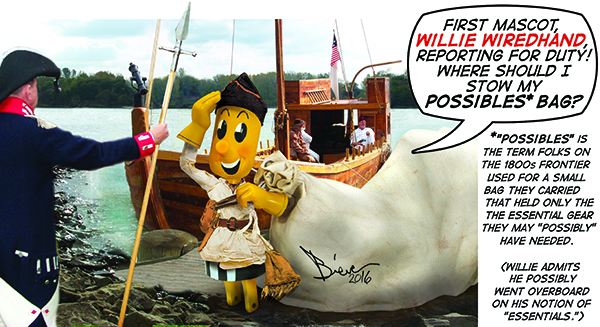 Using Gen. Clark’s cabin as a base, Lewis and Clark completed recruiting what became the core of their crew — nine men from the area. On Oct. 26, 1803, the Corps of Discovery shoved off from Clarksville … and into history.
Using Gen. Clark’s cabin as a base, Lewis and Clark completed recruiting what became the core of their crew — nine men from the area. On Oct. 26, 1803, the Corps of Discovery shoved off from Clarksville … and into history.
On Nov. 5, 1806, after their 8,000 mile round trip, Lewis and Clark returned to Clarksville together. From there, they parted company.
While Northwestern states are most closely associated with Lewis & Clark, Indiana is where it all began. With that handshake on the banks of the Ohio, the names “Lewis” and “Clark” became inextricably linked forevermore.
Stay tuned each month as Willie presents more Indiana “Bicentennial Zingers.”


